Table of Contents
Welcome to a rollicking ride through the wild retro journey of the Atari 2600, a console that transformed living rooms and introduced the world to the concept of digital leisure. Before the age of online streaming and high-definition gaming, this chunky piece of hardware was the pinnacle of home entertainment. So, grab your joystick, and let’s dive into the fascinating universe of the Atari 2600 with 8 fun facts that highlight its eccentric and groundbreaking history.
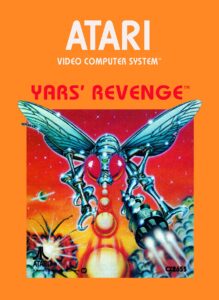
The Dawn of Couch Potatoes: Atari 2600’s Debut
The Atari 2600, initially branded as the Atari Video Computer System (VCS), rolled out in 1977, setting the stage for what would become the couch potato’s favorite pastime. This pioneering console brought the arcade experience straight into the living room, making it a revolutionary step in the world of video gaming. The era of outdoor activity as the sole form of entertainment for kids was about to see a formidable rival. With a modest library of nine launch titles, the Atari 2600 was an instant hit, despite its hefty price tag of $199 – a figure that would translate to quite a dent in today’s wallet, considering inflation.
The introduction of the Atari 2600 wasn’t just about bringing games home; it was about creating a new cultural phenomenon. Families gathered around their television sets, not to watch the evening news or the latest sitcom, but to blast aliens and race cars. The Atari 2600 didn’t just entertain; it mesmerized, turning ordinary TV screens into portals to other worlds. This was the dawn of a new era, where digital entertainment began to take root in the fabric of everyday life, making the Atari 2600 the cornerstone of modern gaming culture.
The impact of the Atari 2600 on society was profound. It not only popularized video gaming as a mainstream hobby but also paved the way for a future where digital entertainment would become ubiquitous. It’s hard to overstate the importance of this console; without it, the video games of today might look very different. The Atari 2600, in its wood-grained glory, was more than just a gaming device; it was a cultural icon that marked the beginning of a new age of home entertainment.
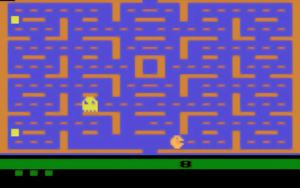
Joystick Wielders: The First Gaming Heroes
With the dawn of the Atari 2600 era came the rise of the first gaming heroes – joystick wielders who mastered the art of pixelated warfare and space exploration. These early gamers were the pioneers of a new frontier, exploring digital realms with a clunky, single-button joystick that became the Excalibur of the video game world. The simple yet innovative design of the Atari joystick made it an icon in its own right, embodying the essence of retro gaming.
These first joystick wielders weren’t just playing games; they were setting the high scores that became the bragging rights in schoolyards and neighborhoods. The Atari 2600 created a competitive arena for gamers, where titles like “Asteroids” and “Space Invaders” became the battlegrounds for these early digital warriors. It was a time of simple pleasures, where the flick of a joystick and the mashing of a single button could lead to hours of entertainment and the occasional blistered thumb.
The legacy of these early gamers lives on, not just in the fond memories of those who were there but also in the evolution of gaming culture. They were the forefathers of a community that would grow to encompass millions worldwide, laying down the foundational ethos of gaming: play, compete, and strive to beat the seemingly unbeatable. The joystick wielders of the Atari 2600 era were the first to take up the digital challenge, paving the way for generations of gamers to come.
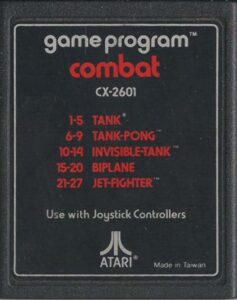
“Combat” and “Pong”: Pixels That Started Wars
In the pantheon of Atari 2600 games, “Combat” and “Pong” hold special places as the pixels that started wars – in the living room, at least. “Pong,” with its simplistic two-dimensional graphics, mimicking table tennis, became an instant classic. It was more than a game; it was a social phenomenon, turning friends into foes and family game night into a competitive sport. “Combat,” on the other hand, brought the thrill of tank battles and dogfights into homes, offering a variety of game modes that kept players engaged and on the edge of their seats.
These games were deceptively simple but incredibly addictive. They required quick reflexes, strategic thinking, and a steady hand on the joystick. The joy of scoring a point in “Pong” or landing a hit in “Combat” was a novel experience, giving players a sense of achievement that was previously exclusive to the realm of physical sports or board games. These titles laid the groundwork for the multiplayer gaming sessions that are now a staple of the industry, proving that video games could be a communal activity long before online multiplayer became a possibility.
The legacy of “Combat” and “Pong” extends beyond just entertainment; they were the harbingers of the e-sports phenomenon. Though they were simple, the competitive nature of these games foreshadowed a future where video game competitions would fill arenas and attract viewers from around the globe. “Combat” and “Pong” were not just games; they were the beginning of a revolution, turning pixelated battles into a competitive and social pastime that continues to thrive today.
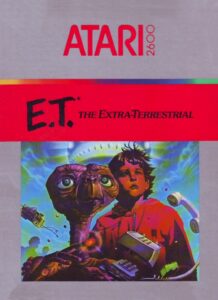
The E.T. Fiasco: From Space to Landfill
The Atari 2600’s journey wasn’t without its turbulence, and no story highlights this better than the infamous E.T. fiasco. In 1982, Atari secured the rights to create a video game based on the blockbuster film “E.T. the Extra-Terrestrial.” With expectations sky-high, the game was rushed to market, developed in a mere five weeks to coincide with the holiday season. The result was a game that was confusing, nearly unplayable, and, to the dismay of many, a far cry from the cinematic masterpiece it was based on.
The fallout was catastrophic. Millions of unsold and returned cartridges became a symbol of the video game industry’s first major crash. In a move that has since become the stuff of legend, Atari was rumored to have buried unsold E.T. cartridges in a New Mexico landfill, a tale that was confirmed decades later when a dig unearthed these relics of a bygone era. The E.T. game became a cautionary tale of the dangers of overhype and the importance of quality control in game development.
Despite its notoriety, the E.T. debacle also serves as a testament to the enduring allure of the Atari 2600. The console was so beloved that even the failure of one of the biggest entertainment franchises couldn’t tarnish its legacy. The story of E.T. is now a cherished part of video game folklore, a reminder of an era when gaming was still finding its feet, and even the biggest mistakes could become the most fascinating footnotes.
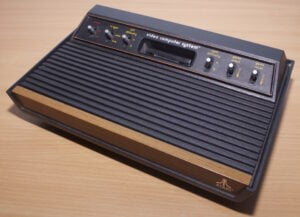
Wood Paneling: Because Your Console Needs Style
In an age where aesthetics plays a crucial role in the appeal of gadgets, the Atari 2600 stood out with its distinctive wood paneling. This wasn’t just a gaming console; it was a piece of home decor, blending seamlessly with the shag carpets and wood-paneled walls of the 1970s and 1980s living rooms. The choice of wood grain finish gave the Atari 2600 a warm, inviting look, a far cry from the cold, futuristic designs of later gaming systems.
This design choice was more than just a visual appeal; it was a statement. The Atari 2600 wasn’t merely a toy; it was an integral part of the family living space, deserving of a spot next to the television and stereo system. The wood paneling helped bridge the gap between technology and home environment, making the console more acceptable to parents wary of inviting digital distractions into their homes.
The wood-grained finish of the Atari 2600 has become an iconic symbol of retro gaming. It represents a time when video game consoles were breaking new ground, not just in technology but in how they fit into our lives. The classic look of the Atari 2600 evokes nostalgia, reminding us of a simpler time in gaming when style and substance went hand in hand.

The Legacy Lives On: Not Just Your Dad’s Atari
The Atari 2600 may be a relic of the past, but its legacy is anything but forgotten. This console laid the groundwork for the gaming industry, introducing concepts and standards that are still in use today. From the idea of licensed games from 3rd parties to the development of game genres that remain popular, the Atari 2600 was a trailblazer. Its influence can be seen in the design and gameplay of modern video games, proving that good ideas have staying power.
Today, the Atari 2600 enjoys a renaissance among collectors and retro gaming enthusiasts. The simplicity and nostalgia of its games have a unique charm that modern, high-definition games can’t replicate. Events like the uncovering of the E.T. cartridges and the release of modern consoles styled after the Atari 2600 demonstrate that there’s still a place in the world for this pioneer of home gaming.
More importantly, the Atari 2600’s legacy is about the joy of gaming. It reminds us that at the heart of every video game, whether pixelated or photorealistic, is the potential to bring people together, to challenge them, and to entertain. The Atari 2600 may be your grandfather’s console, but its spirit lives on in every game that follows in its footsteps, ensuring that its wild, retro journey continues.
The Atari 2600’s journey from the living room staple to retro icon is a testament to its impact on gaming and pop culture. Through its highs and lows, this console has left an indelible mark on the industry, shaping the way games are played and developed. It stood as a beacon of innovation and is now a reminder of simpler times.
Feel free to check out our article on the history of GI Joe, where we cover GI Joe Cobra Strike!
The Top 10 Best Sellers
#1: Pac-Man – 8,095,586 units
#2: Space Invaders – 6,252,229 units
#3: Donkey Kong – 4,180,523 units
#4: Pitfall! – 4,000,000 units
#5: Frogger – 4,000,000 units
#6: Asteroids – 3,832,886 units
#7: Defender – 3,040,684 units
#8: E.T. the Extra-Terrestrial – 2,740,232 units
#9: Ms. Pac-Man – 2,311,428 units
#10: Demon Attack – 2,000,000 units